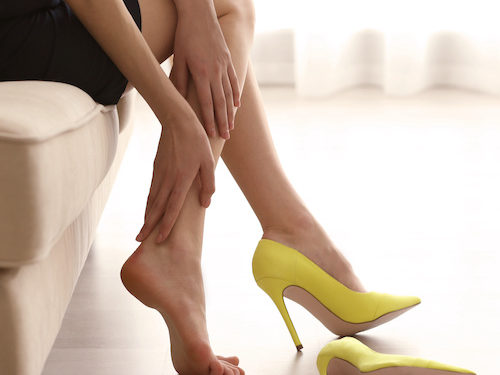Balancing the Hype and Harm of High Heels
The appeal of the high heel has spanned centuries, but what is the motivation to strap a 4-inch peg on the back of your foot and try to walk around? Psychological science says that incentives are multi-faceted and can range in a spectrum from utility to vanity and include reasoning such as:
- Wanting to be taller/reach things/feel more powerful in groups.
- The desire to seem more attractive/sexier gait/enhancing the appearance of the calf muscle/the illusion of elongating the legs or looking slimmer.
- Aspiring to be on top of fashion trends/help clothes hang better/status symbol/look more affluent.
Whatever the reason, high heels are big business. The global high heel footwear market is projected to grow by USD $2.39 billon by 2027. But what is the real cost for consumers who regularly buy and wear high heels?
Paying the Physical Price
Each foot is comprised of three arches, 26 bones, 30 joints and more than 100 muscles, tendons and ligaments. When you slip on a pair of heels, the biomechanical changes that occur in the feet and up the kinetic chain are immediate. With gait, changes were found in the rollover function of the foot, ankle, knee joints and lower back. Step length and balance are also compromised which increases the risk for falls, stress fractures and sprain/strain injuries of the ankle.
An increase in heel height forces the foot into more pronounced plantar flexion (pointing the toes toward the ground) which, in turn, affects the knee and the curve in the lower back. Low back and leg pain are common due to compressive forces and as major joints all the way up the kinetic chain become affected from the unnatural shift in heel height.
In the long term, pain and deformity are very real concerns. When you think of the shape of most high heels, the deformities fit like puzzle pieces as individuals force their feet to adapt to the shape of their shoes:
- Hallux valgus (aka a bunion on the inside of the foot near the big toe) has been noted in heel wearers as is a deformity of the pinky toe creating a similar situation on the outside of the foot.
- Haglund’s deformity occurs as a lump on the back of the heel(s) near the Achilles tendon attachment which can then lead to pain and bursitis. Since it often develops in people who wear pump-style heels, it is also referred to as ‘pump bump.’
- Wearers are also at higher risk of developing hammer toes, corns, heel spurs, plantar fasciitis, flattened arches, stress fractures, knee damage and low back pain.
Studies have shown that regular high heel use may compromise muscle efficiency in walking causing wearers to often experience discomfort and muscle fatigue due to structural and functional changes in the muscles of the lower leg. A 2022 study concluded that balance control was affected for regular wearers not only while in the shoes, but also it did not correct itself in a natural barefoot state which is evidence of lasting change.
Because of the stress and wear and tear to the cartilage of joints, osteoarthritis is another concern. High heels cause stress to the entire foot and the change in foot strike translates up the kinetic chain. Knee osteoarthritis in particular has been an ongoing finding due to altered biomechanics.
In healthcare offices low back pain has also been an ongoing and prevalent finding in women who wear heels. With your toes plantar-flexed, the joint function of the foot is altered, the hips shift forward and your spine has to balance out the weight by overarching backwards, all of these changes start with the unnatural stresses on the foot joints which move all the way up the kinetic chain to the spine.
Tips for Balancing High Heels with Health
It’s clear that high heels are here to stay and you don’t have to give them up altogether. However, there are several strategies that you can take to mitigate the risks involved with wearing them.
- Choose flexible shoes with a wider toe box.
- Try not to go over two inches. Even a heel as low as 3/4 inch has
been found to increase the pressure on the forefoot by as much as 22%. - Select a wider heel base (vs. skinny heels) to disperse weight and increase balance.
- Be mindful of how often you wear heels. Only wear them occasionally/when absolutely necessary. Wear comfortable shoes to and from the office and only put the heels on for meetings, presentations or special occasions.
- Perform exercises to keep the stabilizing muscles of your foot strong and your calf muscles stretched.
Wearers may also find benefit from custom orthotics to maximize the support of the foot while wearing heels. A study published in the Archives of Physical Medicine and Rehabilitation found that 40% of patient participants had increased function and a significant reduction in low back pain through a combination of custom orthotics and chiropractic care. Your doctor of chiropractic (DC) understands the complex structure of the foot and can support healthy foot function through evaluating and adjusting the joints of the foot, knee, hip and low back (up the kinetic chain) to reduce pain and keep joints functioning optimally. DCs can also advise on footwear, demonstrate exercises for foot stability and help you to obtain custom orthotics for your heels so that you can maximize function, balance and strength when wearing them.

